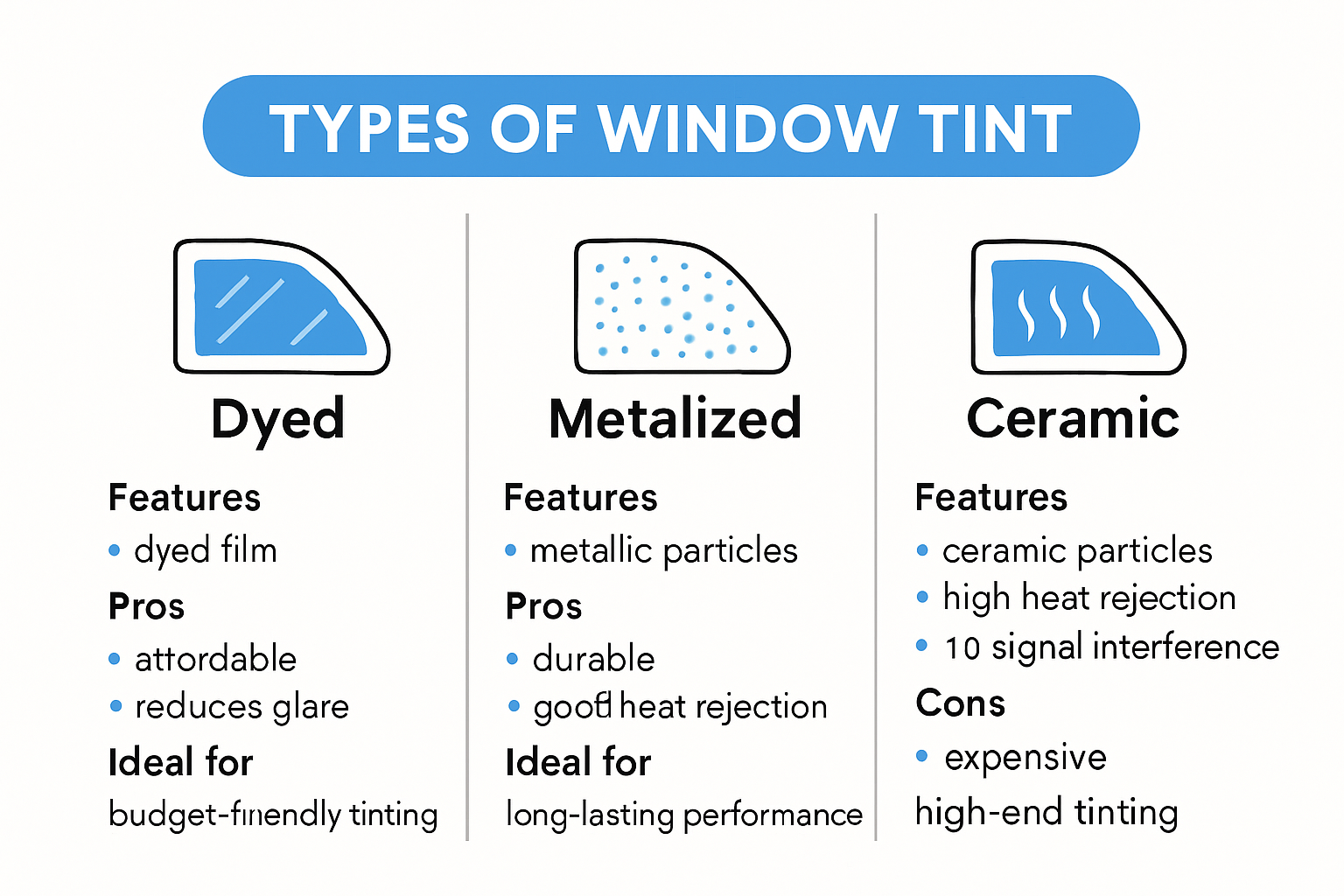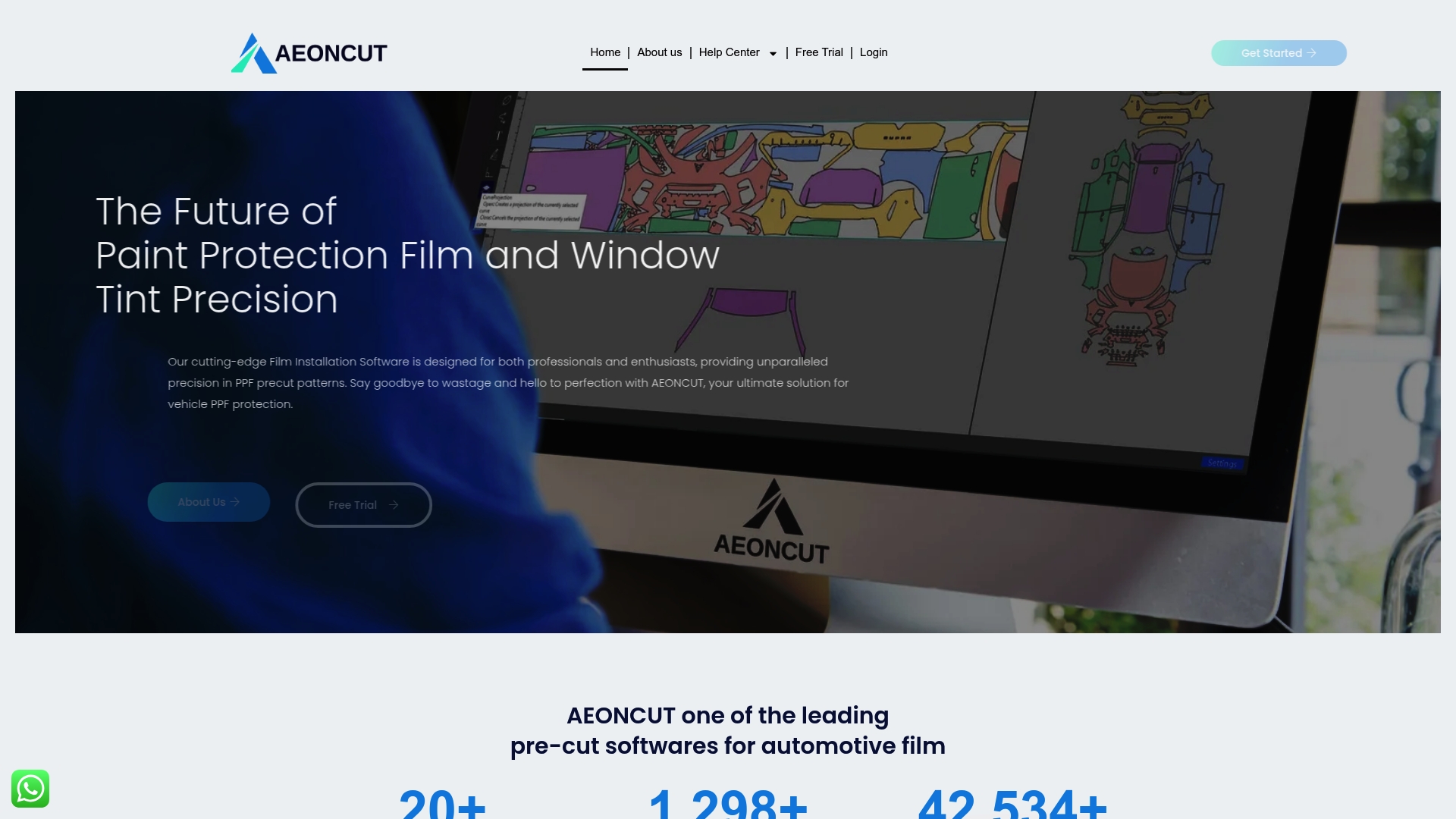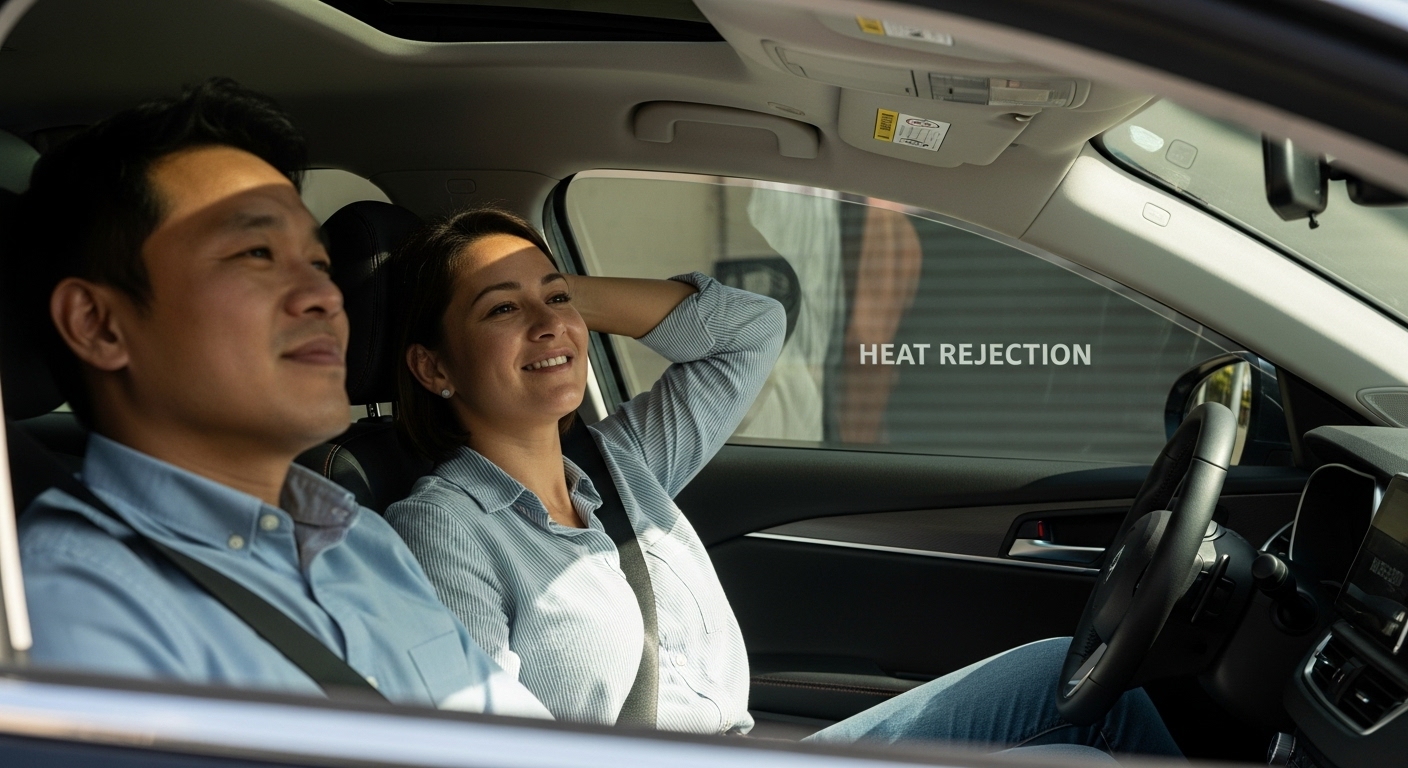

Window tinting is not just about style. The latest figures show that ceramic window tints can block over 99 percent of harmful UV rays and cut interior heat by up to 50 percent. That might sound like a simple upgrade, but most dealers are still missing out on the real business value behind these advanced films. Here’s the truth every installer and dealer needs to hear.
Table of Contents
- Understanding Main Types Of Window Tint Film
- Key Benefits And Applications For Professionals
- Choosing The Right Tint Film For Your Business
- Expert Tips For Installing And Selling Window Tint
Quick Summary
| Takeaway | Explanation |
|---|---|
| Understanding Film Types is Crucial | Different window tint films—dyed, metalized, and ceramic—offer unique benefits and limitations, making it essential for professionals to recommend the right type based on performance needs and client preferences. |
| Maximise Vehicle Performance with Tint | Proper window tinting can significantly enhance vehicle performance by reducing interior heat, blocking UV rays, and preserving interiors, making it a valuable service to offer clients. |
| Strategic Film Selection is Key to Success | Selecting the appropriate window tint film involves considering window characteristics, client objectives, and budget, ensuring that installers provide tailored solutions for their clients. |
| Technical Mastery Enhances Reputation | Mastering installation techniques, including surface preparation and bubble elimination, helps professional installers distinguish themselves from competitors and build client trust. |
| Sales and Customer Engagement Matter | A consultative sales approach that addresses client needs and clearly communicates value can lead to premium pricing and increased customer loyalty. |
Understanding Main Types of Window Tint Film
Professional window tint installers must understand the distinct characteristics of different window tint films to provide optimal solutions for clients. Window tint technology has evolved significantly, offering multiple film types that address specific performance requirements and aesthetic preferences.

Dyed Window Tint Films: Affordable Protection
Dyed window tint films represent the most basic and economical option in the market. According to research from materials science publications, these films are produced by immersing a clear polyethylene terephthalate (PET) layer into a specialized dye bath. The process creates a uniform tint that absorbs infrared and visible radiation, effectively reducing interior heat and glare.
The primary advantages of dyed window tint films include:
- Cost effectiveness: Significantly lower price point compared to advanced tint technologies
- Basic heat reduction: Absorbs some solar radiation
- Aesthetic appeal: Provides a classic, uniform dark appearance
However, professionals should note these films have limitations in long-term performance and heat rejection compared to more advanced options.
Metalized Window Tint Films: Enhanced Protection
Metalized window tint films represent a more sophisticated approach to solar protection. Scientific research reveals these films are created by embedding microscopic metallic particles within multiple film layers through advanced deposition or sputter processes.
Key characteristics of metalized window tint films include:
- Superior heat reflection: Metallic particles effectively block and reflect solar radiation
- Enhanced durability: Added structural strength from metallic embedded particles
- Increased shatter resistance: Provides additional protection during impact scenarios
Professional installers should be aware of potential drawbacks, such as potential interference with electronic signals like GPS and cellular communications.
Ceramic Window Tint Films: Advanced Technology
Ceramic window tint films represent the pinnacle of window tint technology. According to materials science publications, these films utilize non-metallic, nano-ceramic particles to deliver exceptional performance characteristics.
Professional installers appreciate ceramic films for their:
- Exceptional heat rejection: Superior thermal performance without signal interference
- Optical clarity: Maintains crystal-clear visibility
- Comprehensive UV protection: Blocks significant amounts of harmful ultraviolet radiation
- Electronic compatibility: No disruption to vehicle electronic systems
While ceramic films represent the most advanced option, they typically come with a higher price point, reflecting their sophisticated manufacturing process and superior performance capabilities.
Understanding these window tint film types enables professional installers to recommend the most appropriate solution based on client needs, vehicle specifications, and budget constraints. Each film type offers unique benefits, and selecting the right technology requires careful consideration of performance, aesthetic, and practical requirements.
Below is a comparison table to help professionals quickly evaluate the main types of window tint films, their key features, benefits, and potential drawbacks.
| Film Type | Key Benefits | Main Drawbacks | Typical Use Case |
|---|---|---|---|
| Dyed | Most affordable, basic heat reduction, classic dark look | Lower durability, less heat rejection | Entry-level, budget-conscious |
| Metalized | Superior heat reflection, added strength, shatter resistance | Signal interference (GPS/Cell), higher cost than dyed | Commercial/fleet, durability-focused |
| Ceramic | Exceptional heat & UV rejection, optical clarity, no signal interference | Highest cost | Premium/personal/luxury vehicles |

Key Benefits and Applications for Professionals
Professional window tint installers must understand the comprehensive benefits and strategic applications of different window tint technologies to deliver exceptional value to their clients across various industries and vehicle types.
Performance Optimization for Vehicle Protection
Window tint films offer far more than aesthetic enhancement. According to AAA automotive research, ceramic window tint technologies can block over 99% of harmful UV rays and potentially reduce a vehicle’s interior temperature by up to 50%. This remarkable heat rejection capability provides significant advantages for vehicle owners.
Key performance benefits for professionals include:
- Thermal Management: Dramatically reduces interior heat buildup
- UV Protection: Blocks nearly all harmful ultraviolet radiation
- Interior Preservation: Prevents dashboard and upholstery fading
- Enhanced Comfort: Maintains consistent interior temperature
Below is a summary table outlining the key performance benefits and their positive effects for professional installers to communicate with clients.
| Benefit | Description | Impact on Client Experience |
|---|---|---|
| Thermal Management | Reduces interior heat buildup | Cooler cabin, less AC use |
| UV Protection | Blocks up to 99% of harmful UV rays | Healthier environment, prevents skin damage |
| Interior Preservation | Prevents dashboard and upholstery fading | Prolongs vehicle interior lifespan |
| Enhanced Comfort | Maintains consistent interior temperature | Improved comfort and driving pleasure |
Strategic Applications Across Industries
Window tint applications extend well beyond personal vehicles. Professional automotive research demonstrates versatile uses across multiple sectors:
- Commercial Fleet Management: Reduces driver fatigue and enhances vehicle longevity
- Luxury Vehicle Customization: Provides premium aesthetic and functional upgrades
- Commercial Transportation: Improves passenger comfort and vehicle efficiency
- Security Vehicles: Offers enhanced privacy and temperature control
Professional Installation Considerations
Successful window tint implementation requires comprehensive understanding of film characteristics and installation techniques. Automotive detailing resources highlight critical factors professionals must consider:
- Material Compatibility: Understanding film performance with different glass types
- Legal Compliance: Adhering to regional tint darkness and reflection regulations
- Client Expectations: Matching film technology to specific performance requirements
- Long-Term Performance: Evaluating durability and potential maintenance needs
Professional window tint installers who master these nuanced considerations can differentiate themselves in a competitive market. By offering expert consultation and precision installation, they transform window tinting from a simple aesthetic upgrade to a comprehensive vehicle protection and performance enhancement service.
Understanding the intricate balance between technological capabilities, client needs, and industry standards enables professionals to deliver exceptional window tint solutions that provide tangible value across diverse applications.
Choosing the Right Tint Film for Your Business
Professional window tint installers understand that selecting the appropriate film is a strategic decision that directly impacts client satisfaction and business success. The selection process requires careful evaluation of multiple technical and practical factors.
Strategic Film Selection Criteria
According to energy product evaluation research, choosing the right window tint film involves comprehensive assessment of several critical factors:
- Window Characteristics: Analyze existing glass type, age, and structural condition
- Climate Considerations: Evaluate local temperature and sunlight exposure
- Client Objectives: Understand specific performance requirements and aesthetic preferences
- Budget Constraints: Balance performance capabilities with financial limitations
Advanced Film Technology Options
Detailed industry research reveals multiple specialized film technologies for professional installers:
- Spectrally Selective Films: Transmit visible light while reflecting infrared radiation
- Nano Technology Films: Utilize advanced polyester layering for precise solar control
- Dual Reflective Films: Provide exterior privacy with interior visibility
- Low-Emissivity Films: Offer enhanced thermal management across temperature ranges
Professional Installation Considerations
Successful window tint implementation extends beyond film selection. Adhesive technology experts highlight critical installation factors:
- Adhesive Compatibility: Match film with appropriate bonding technology
- Precision Application: Ensure minimal air bubbles and perfect alignment
- Surface Preparation: Thoroughly clean and assess glass surfaces
- Quality Control: Implement rigorous post-installation inspection protocols
Professional window tint installers who master these nuanced selection and application techniques can transform window tinting from a basic service to a sophisticated, value-added solution. By understanding the intricate balance between technological capabilities, client needs, and installation precision, businesses can differentiate themselves in a competitive market.
The most successful professionals recognize that window tint selection is not merely about choosing a product but about delivering a comprehensive solution that meets specific client requirements while demonstrating technical expertise and commitment to quality.
Expert Tips for Installing and Selling Window Tint
Professional window tint installers must develop a comprehensive approach that combines technical expertise, customer communication, and strategic business practices to succeed in this competitive market.
Technical Installation Mastery
Successful window tint installation requires precision and advanced technical skills. Professional automotive detailing resources emphasize several critical technical considerations:
- Surface Preparation: Thoroughly clean and inspect glass surfaces before application
- Humidity Control: Manage environmental conditions during installation
- Precise Cutting: Use advanced cutting techniques to ensure perfect film fit
- Bubble Elimination: Implement professional techniques to remove air pockets
Below is a process checklist highlighting the key steps for professional window tint installation to guide consistency and quality.
| Step | Action Description | Essential? (Yes/No) |
|---|---|---|
| 1. Surface Preparation | Clean and inspect glass thoroughly | Yes |
| 2. Humidity Control | Manage installation environment humidity | Yes |
| 3. Precise Cutting | Accurately cut film to match window shape | Yes |
| 4. Application | Carefully apply film to glass | Yes |
| 5. Bubble Elimination | Use professional tools to remove air pockets | Yes |
| 6. Quality Inspection | Check for flaws, alignment and adhesion | Yes |
Mastering these technical skills separates professional installers from amateur practitioners. Each installation represents an opportunity to demonstrate technical proficiency and build long-term client trust.
Sales and Customer Engagement Strategies
Effective window tint sales go beyond technical capabilities. Automotive industry sales training recommends a consultative approach that focuses on client needs and value proposition:
- Needs Assessment: Conduct comprehensive client consultations
- Solution Matching: Align specific film technologies with client objectives
- Value Communication: Clearly articulate long-term benefits and cost savings
- Transparent Pricing: Provide clear, detailed pricing structures
Professionals who position themselves as solution providers rather than simple product sellers can command premium pricing and build repeat business.
Compliance and Quality Assurance
Navigating legal requirements and maintaining high-quality standards are crucial for sustainable business success. Automotive regulatory guidelines highlight key compliance considerations:
- Local Regulations: Understand and adhere to regional tint darkness restrictions
- Warranty Management: Offer comprehensive installation warranties
- Continuous Training: Stay updated on emerging technologies and techniques
- Quality Control: Implement rigorous post-installation inspection protocols
Professional window tint installers who combine technical excellence, strategic sales approaches, and strict compliance create a robust business model that attracts and retains high-value clients.
Success in the window tint industry requires more than technical skill. It demands a holistic approach that balances precision installation, customer-centric communication, and ongoing professional development. By treating each installation as an opportunity to demonstrate expertise and value, professionals can differentiate themselves in a competitive market.
Frequently Asked Questions
What are the main types of window tint films?
The main types of window tint films are dyed, metalized, and ceramic. Each offers unique benefits in terms of cost, heat rejection, and UV protection.
How does ceramic window tint compare to other types?
Ceramic window tint is renowned for its advanced technology, offering exceptional heat and UV rejection without interference with electronic signals, making it ideal for premium vehicles.
What are the benefits of using window tint in vehicles?
Window tint provides several benefits, including significant heat reduction, UV protection, enhanced interior preservation, and improved comfort, making it a practical upgrade for vehicle owners.
How can installers choose the right tint film for their clients?
Installers can choose the right tint film by assessing window characteristics, understanding client objectives, considering budget constraints, and evaluating local climate conditions.
Discover Precision and Efficiency for Every Window Tint Project
Mastering the latest window tint technologies and selecting the right film have never been more important, especially with customer expectations rising for heat reduction and flawless results. Yet, even the best installers and dealers face one constant challenge: wasted material, inaccurate fits, and labor time lost when templates fall short, or patterns do not align with complex auto glass. You need reliability and accuracy that match your technical skills and the quality of tint films you are offering.

If you are ready to transform your workflow and guarantee clean, perfect installations every time, experience the benefits of AEONCUT’s advanced pre-cut pattern software. Our cloud-driven platform offers an extensive library of precise, customisable patterns, paired with AI-powered auto-nesting for maximum material efficiency. Do not let cut quality or wasted film hold your business back. Start your journey at AEONCUT’s main platform and explore detailed resources like the pattern blog and FAQs before you subscribe. Your competitive edge starts here – act now to streamline your process and deliver premium results on every tint install.



